Successful Outsourcing: Tracking Global CRO Usage
Applied Clinical Trials
New survey captures sponsors changing global usage of, and relationships with, CRO partners.
Demand for contract clinical research services continues to grow rapidly and underscores the integral role that outsourcing plays in drug development. Additionally, usage of full-service and niche-services contract research organizations (CROs) is evolving as sponsors react to changing portfolio requirements, operating needs, and global economic conditions.1
This year, biopharmaceutical companies are expected to spend in excess of $10 billion (US) worldwide on contract clinical service providers—net of pass through costs such as central lab fees and investigator grants. Annual growth in spending on CRO services—13.4% since 2001—has well outpaced the 9.1% annual growth rate in total global development spending during that period.2
A number of factors are driving the growth in outsourcing: Global clinical trial volume and scope is increasing while drug developers face significant capacity constraints. The number of projects in worldwide development has grown 6% annually since 2002, yet many major pharmaceutical and biotechnology companies have not increased their internal clinical research headcount. These capacity constraints are expected to worsen as sponsors reduce and consolidate their R&D infrastructure in response to a global economic downturn.3
Between 2000 and 2008, the proliferation of small and mid-sized companies conducting clinical research programs also stimulated demand for outsourcing. Smaller companies, many of them biotechnology firms, outsource a higher relative proportion of their total clinical research portfolio in order to obtain expertise that falls outside their core capabilities. This year, however, facing tight access to capital, many smaller companies have been forced to downsize and divest their development operations resulting in a strong reduction in their demand for outsourcing.
CRO contribution to development performance has also helped stimulate demand. Many sponsor companies have found that CROs can provide faster cycle times at comparable quality, when they are used effectively. These findings were confirmed in a study conducted by the Tufts Center for the Study of Drug Development in 2006.4
As global economic conditions continue to challenge the drug development enterprise, a rising number of sponsors—large, medium, and small—are looking for new ways to better leverage the performance of their CRO partners while addressing intensifying capacity, quality and cycle time requirements.
With this as a backdrop, and as a follow-up to CRO usage surveys that we have conducted in collaboration with Applied Clinical Trials during the past decade, we conducted a new survey among biopharmaceutical companies to understand how their outsourcing practices and partnerships continue to evolve. It is our hope that the results will inform drug developers and service providers alike about how CROs are being used and the future direction of sponsor–CRO collaborations.
Survey methods
A 32-item survey was emailed to a targeted subgroup of subscribers to Applied Clinical Trials—biopharmaceutical (i.e., pharmaceutical and biotechnology) companies—during February and March 2009. In total, 392 individuals responded to the questionnaire.
Fifty-two percent of respondents described their primary job function as middle management/operational. Senior management accounted for 29%, and the remaining 19% chose "other." Female (52%) and male (48%) respondents were nearly equally represented, and two-thirds of the respondents were between the ages of 30 and 49.
Overall, respondents reported a high level of experience in clinical research. Fifty-five percent of respondents have three or more years of experience in drug development. Most respondents (83%) reported being directly involved in outsourcing. The majority (70%) said they were involved in managing sponsor-provider relationships; 61% report they are responsible for selecting providers and 55% for deciding whether to outsource a study, function or specific activity.
Respondents represented a cross-section of small, medium, and large pharmaceutical, specialty pharmaceutical, biologics, and medical device companies. The proportion of respondents from smaller companies (<$100 million annual R&D spending) in the 2009 survey was greater than the proportion in our 2005 survey, where small, medium, and large companies were equally represented.
In the present survey, smaller companies comprised nearly half of the respondents (56%). One-out-of five responses came from large (>$500 million) sponsors and one-out-of-four from mid-size sponsors.
The majority of respondents were from the United States (65%), with one-third based in the Northeast (36%), and one-fourth based in each southern region: the Southeast (24%) and Southwest (24%). Western Europe accounted for (16%). Fewer respondents were from Central/Eastern Europe (9%), Canada (3%), and Asia (4%).
Current usage
Similar to the results of our 2005 survey, sponsors continue to outsource a wide variety of functions in 2009, from design through site selection, study conduct through medical writing. Activities most often outsourced include data collection/study monitoring (81% report "very often" or "occasionally"); data management (75%); preparing and collecting site documents (73%); patient recruitment assistance (71%); and electronic data capture (71%) [see Table 1].
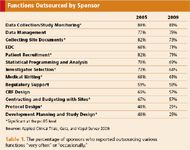
Functions Outsourced by Sponsor
Significant differences (p<.01) were observed between sponsors by size of R&D spending and frequency of outsourcing by function. Smaller companies are utilizing CROs at a higher level than their larger counterparts across nearly all activities and functions with few exceptions; larger sponsors appear to be outsourcing their site support needs at a higher relative level than their smaller peers.
Compared to our 2005 survey results, sponsors appear to be scaling back on their use of CROs for upfront, project initiation activities including development planning and protocol design. Sponsors also appear to be scaling back on their use of CROs to provide investigative site support services (e.g., site selection, patient recruitment support, and contracting and budgeting with sites).
We also observed a significant decline in reported use of CROs for data collection and study monitoring (81% in 2009 versus 89% in 2005). This is likely due to sponsors utilizing a variety of competing sources for CRA personnel including staffing agencies and independent contractors.
Indeed, elsewhere in our survey, sponsors report that their use of independent contractors, sometimes referred to as insourcing, has increased dramatically during the past decade. And sponsors have a variety of options to choose from. Staffing agencies, some owned and operated by CROs, offer temporary personnel to fill the need for CRAs, data managers, statisticians, and other research professionals.
Results from our survey indicate that insourcing is gaining popularity. Fifty-six percent of respondents expect to continue their use of independent contractors and an additional 30% plan to increase their use of this resource. A small minority of respondents (14%) said that they expect their level of insourcing to decrease.
Global focus
The use of study sites abroad has increased for a variety of reasons, including greater access to a high volume of treatment-naïve subjects and well-trained professionals, lower costs, and rising infrastructure levels in emerging markets.
Respondents were asked to estimate what percentage of projects in 2009 will involve study sites abroad. Statistically significant (p<.001) differences were observed by level of R&D spending: Larger sponsors are more likely (p<.001) to use sites abroad. This may be due to the fact that smaller companies primarily conduct early stage (e.g., proof of concept) studies, which do not require large numbers of patients and are principally carried out in the United States. North America continues to be the most popular location for conducting clinical studies. Approximately half (49%) of respondents report that 41% or more of studies planned for 2009 will be conducted among investigative sites in North America. Western Europe was second most popular with 26% of respondents, followed by Eastern Europe with 18%. We observed a statistically significant (p<.05 or greater) effect of sponsor size on study placement. Smaller sponsors were less likely to use investigative sites in Eastern Europe, Asia, India, China, and Latin America.
Results of our survey do not support reports and claims that Asia, India, and China will far surpass other global regions with regard to growth in clinical trial activity and outsourcing. In our survey, sponsors report that significantly less contracting was planned for Asia (10%), India (10%), China (6%), and Latin America (6%) in 2009.
Survey respondents rely primarily on large global CROs to conduct studies abroad. More than two-thirds (69%) of the respondents said that they would contract fewer than 20% of study sites abroad to regional CROs.
Usage mix
Similar to our 2005 survey, respondents to the 2009 survey indicate a high willingness to work with a mix of full-and niche-service providers to handle their portfolio needs.
In our survey companies that are low outsourcers (less than 40% of their development budgets) tend to favor managing a broad mix of full-and niche-service providers. High outsourcers (greater than 60% of their overall development budgets) clearly favor working with full-service providers (p<.001).
A majority of sponsors (61%) report that they use less than five CROs. The vast majority (88%) of sponsors use less than 10 CROs each year. Significant differences (p<.001) are observed when comparing sponsors by R&D spending levels. A much higher percentage of small sponsors (75%) and mid-sized sponsors (52%) tend to use fewer CROs, reflecting the more limited volume and requirements of their portfolios. Only one-third of large sponsors reports using less than five CROs annually (see Figure 1).
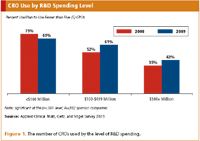
Figure 1
Interestingly, mid-size and large sponsors are planning to consolidate the number of CROs that they use annually. A growing number of larger sponsors now recognize the challenges and inefficiencies inherent in managing a fragmented number of service providers. Consolidating this fragmentation and delegating more responsibility to fewer providers offers an opportunity to reduce operating inefficiency and cost. Smaller sponsors, on the other hand, plan to maintain the number of CROs that they use given their relatively low project volume and high demand for contract expertise and capacity.
More than four-out-of-10 large sponsors (42%) and 61% of mid-sized sponsors plan to use fewer than five CROs in 2009. This compares with 35% of large sponsors and 42% of mid-sized sponsors using five or fewer CROs in 2008. These differences are significant at the p<.001 level. Approximately 70% of small sponsors report using fewer than five CROs annually.
Relationship structures
In 2009, sponsors report using a broad mix of relationship structures. Functional service provider arrangements are widely used by a reported 45% of all sponsors; just more than one-third of sponsors overall (36%) report using transactional relationships; and slightly less than one-quarter (19.7%) of sponsors report using alliance relationship structures.
Significant differences (p<.05 level) in relationship structure use by annual R&D spending levels were observed. Smaller companies report a higher incidence of transactional relationship use and low relative alliance relationship use. Small sponsors typically support only one or a few projects in development where task-oriented outsourcing best meets their need for capacity and operating flexibility. In addition, those small companies receptive to entering alliances are reluctant to do so because they believe it will be difficult to compete for CRO partners when larger sponsors offer substantially higher contract spending levels.
Mid-sized sponsors show the highest incidence (29%) of alliance relationship usage and the lowest comparative incidence of functional service provider (FSP) usage. This may reflect the more nimble ability of mid-sized companies to enter into partnerships supporting broad multifunctional outsourcing. In contrast, large companies have methodically selected individual functions to outsource to accommodate organizational reluctance and legacy processes and systems. Indeed, in our survey, large sponsors report very high relative incidence (50%) of FSP relationship usage and 20% incidence of alliance relationship use (see Figure 2).
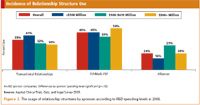
Figure 2
Overall, 57%–64% of sponsors expect their use of various relationship structures to remain the same in 2009. Slightly less than one-third of sponsors overall (30%) expect their use of FSP relationships to "Greatly" increase and to "Somewhat" increase in 2009; 22% and 26% expect their use of transactional and alliance relationships respectively to "Greatly" increase and to "Somewhat" increase.
Significant differences (p<.05 level) in relationship structure use by annual R&D spending levels were again observed with regard to planned 2009 usage.
Although mid-sized companies appear to have established more alliances in 2008—our survey results suggest that small and large company receptivity to forming alliance relationships has increased substantially. A high relative percentage (34%–38%) of small and large sponsors plan to increase "Greatly" and "Somewhat" their use of alliance relationships in 2009. This compares with only 18% of mid-sized sponsors that plan to increase their use of alliance relationships "Somewhat" and "Greatly" in 2009.
A high relative percentage (34%–40%) of mid-sized and large sponsors plan to increase "Greatly" and "Somewhat" their use of FSP relationships. This compares with only 23% of small sponsors that plan to increase "Somewhat" and "Greatly" their use of FSP relationships in 2009.
Budgets and oversight
Approximately one-third of sponsors spent less than 20% of their development budgets on outsourcing; about 40% spent between 21% and 60% of their development budgets on outsourcing; and approximately one-fourth of sponsors spend the majority of their budget (61%+) on outsourcing.
Significant differences (p<.01) were observed when comparing sponsors by size of overall annual R&D spending. A higher percentage (83%) of large sponsor companies tend to spend more than 20% of their overall R&D budgets on outsourcing versus smaller sponsors (61%). This finding is consistent with other survey results suggesting that utilization of CROs is highest among the largest, globally positioned sponsors.
Planned spending levels in 2009 are modestly higher than actual spending levels in 2008. Sponsor companies report that they do not anticipate dramatic increases in spending for contract clinical services.
The majority (75%) of sponsors do not expect to enter into risk-sharing relationships with their CRO partners. Smaller sponsors tend to be more reluctant to enter into risk-sharing arrangements than their larger counterparts (p<.05).
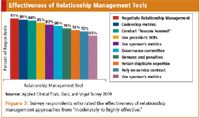
Figure 3
Our survey asked respondents to rate the effectiveness of various relationship management tools to ensure that their CRO providers meet their expectations (see Figure 3). A large majority of respondents rate the following approaches as "moderately to highly effective":
- Negotiating a relationship management plan with the provider (91%)
- Codeveloping performance metrics with the provider (89%)
- Conducting periodic "lessons learned" reviews with the provider (88%)
- Allowing the provider to use its SOPs after the sponsor has reviewed them for their adequacy (85%).
The approach of giving the provider the sponsor's performance metrics was rated less effective than codeveloping metrics. Lower ratings were given to incorporating bonuses and penalties into the service contract, retaining duplicate expertise in-house to oversee the provider, and insisting that the provider follow your SOPS.
Future drivers
The top perceived drivers of increased outsourcing are: capacity needs in part due to downsizing of in-house staff; rising demand due to the growing volume of clinical trial activity; and increasing global placement of clinical trials.
Forty percent of survey respondents identified "downsizing" as the principal factor driving increased use of CROs in 2009. Trial volume was rated at nearly the same level (39%). Approximately one-third (30%) of sponsors rate global trial placement, focus on core competencies (27%), the need to control costs (24%), safety requirements (16%), and profitability pressures (5%) as drivers of outsourcing.
The top perceived drivers of increased CRO use did not vary notably by level of R&D spending with one exception: A slightly higher percentage of large sponsor organizations ($500+ million) rated their focus on "core" competencies as a top driver than did those rating the globalization of clinical trials. This may be in part due to their relative experience with global trial management and to their receptivity to portfolio-based relationships characterized by complementary competencies.
Conclusions
The results of our survey offer a number of key takeaways, most notably the wide variety of activities and functions outsourced on a global level, the continued use of multiple sources (outsourcing and insourcing) for personnel capacity, and the growing use of different relationship structures. Rising capacity demands combined with a difficult global operating environment are pressuring sponsors to derive ever-higher levels of performance and efficiency in their outsourcing relationships. The growing prevalence of functional service provider and alliance relationships holds the promise of delivering decreased operating expenses, decreased cycle times, and increased operating flexibility.
In addition, more efficient use of outsourcing partnerships will impact the balance of R&D spending. Under utilized assets and non-core activities will likely be outsourced to CROs and specialty providers. Capital investments in non-core functions will be reduced or eliminated. Sponsors will focus on their core and strategic mission to drive innovation in health care.
As always, we are excited about the evolving direction of sponsor–CRO relationships and look forward to reporting the results of future surveys.
Author acknowledgements
The authors wish to thank the Applied Clinical Trials staff, and Rachael Zuckerman at Tufts CSDD for their assistance in conducting this survey and in analyzing the results.
Kenneth A. Getz, MBA, is a senior research fellow at the Tufts CSDD and founder and chairman of CISCRP, both in Boston, MA, email: Kenneth.getz@tufts.eduJohn R. Vogel, PhD, is a drug development outsourcing consultant at John R. Vogel Associates, Inc., in Wailea, HI, email john@jrvogel.com
References
J. Vogel and K. Getz, "Successful Outsourcing: Tracking the Evolving Use of Full-Service and Niche-Service CROs," Applied Clinical Trials, June 2005, 54-60.
R. Muken and M. Cherny, "CRO 101: From Skeptics to Saviors," Deutsche Bank, Global Markets Report, May 12, 2009, 29-32.
K. Getz and R. Zuckerman, "Clinical Research Outsourcing," Contract Pharma, June 2008, 66-71.
K. Getz, "CRO Contribution to Drug development Substantial and Growing," The Impact Report, Tufts Center for the Study of Drug Development at Tufts University, 8 , 1-4 (2006).
FIND OUT MORE
To see this article with Web exclusive figures, visit appliedclinicaltrialsonline.com
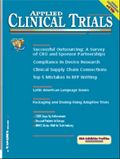
Improving Relationships and Diversifying the Site Selection Process
April 17th 2025In this episode of the Applied Clinical Trials Podcast, Liz Beatty, co-founder and chief strategy officer, Inato, discusses a number of topics around site engagement including community-based sites, the role of technology in improving site/sponsor relationships, how increased operational costs are impacting the industry, and more.
Behind the Buzz: Why Clinical Research Leaders Flock to SCOPE Summit
February 7th 2025In this episode, we meet with Micah Lieberman, Executive Conference Director for SCOPE Summit (Summit for Clinical Ops Executives) at Cambridge Innovation Institute. We will dive deep into the critical role of collaboration within the clinical research ecosystem. How do we bring together diverse stakeholders—sponsors, CROs, clinical trial tech innovators, suppliers, patients, sites, advocacy organizations, investors, and non-profits—to share best practices in trial design, program planning, innovation, and clinical operations? We’ll explore why it’s vital for thought leaders to step beyond their own organizations and learn from others, exchanging ideas that drive advancements in clinical research. Additionally, we’ll discuss the pivotal role of scientific conferences like SCOPE Summit in fostering these essential connections and collaborations, helping shape the future of clinical trials. Join us as we uncover how collective wisdom and cross-industry partnerships are transforming the landscape of clinical research.
FDA-Approved Gene Therapy Beqvez Shows Sustained Efficacy, Safety in Long-Term Hemophilia B Trial
April 17th 2025Beqvez (fidanacogene elaparvovec), an FDA-approved one-time gene therapy for hemophilia B, demonstrated sustained factor IX expression, low bleeding rates, and a favorable safety profile over long-term follow-up.